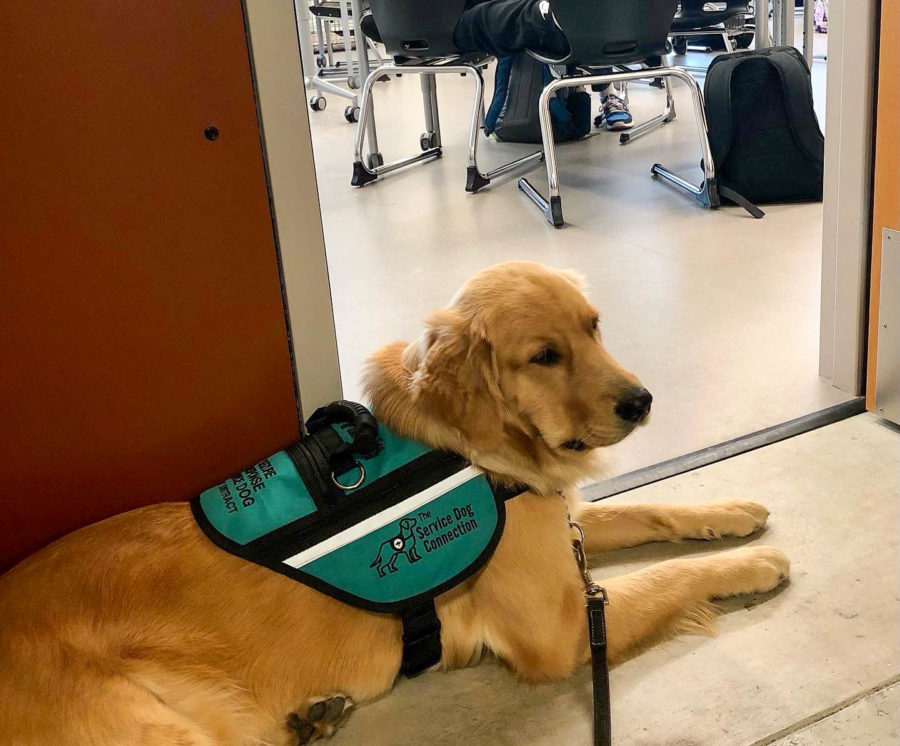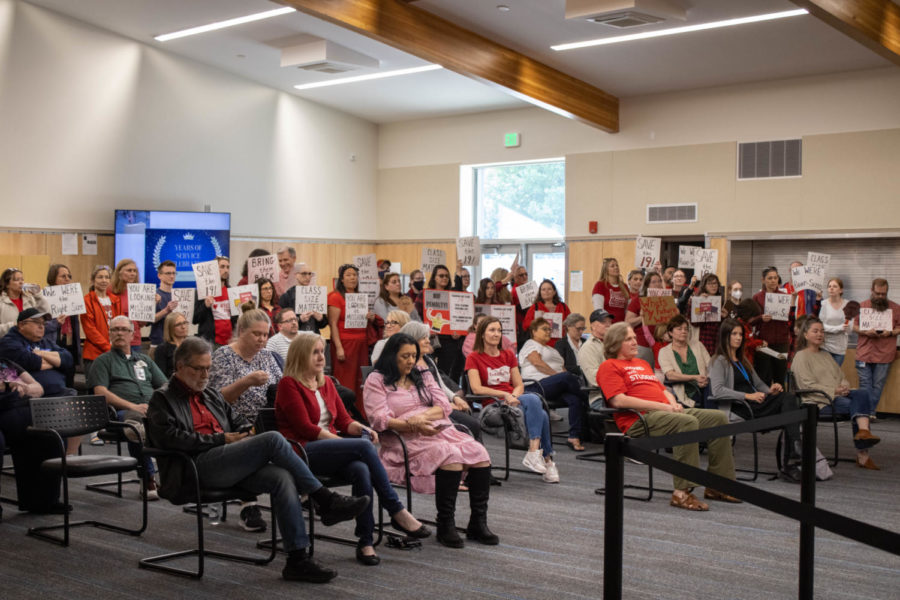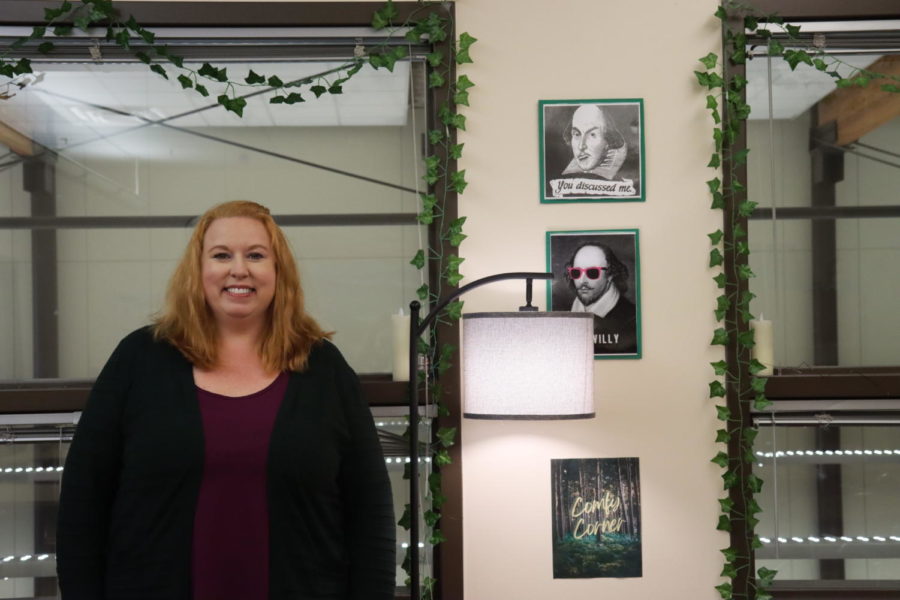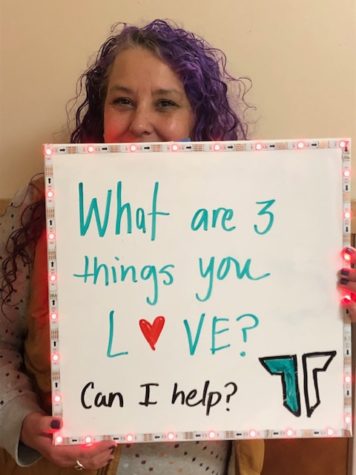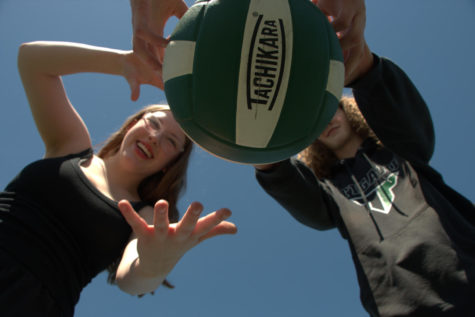What do you get when you cross a dog and a calculator?
Willow waits patiently by the door to Ann Schoblaske’s math class. She left her work at school to be united with her human on Oct. 29.
November 10, 2021
A friend you can count on, or math teacher Ann Schoblaske and her service dog in training, Willow.
Schoblaske found that sharing pets was the best way to get her students engaged over online school and wanted to find a way to bring that energy into the classroom.
Schoblaske volunteers for The Service Dog Connection that is run in Southern Oregon. As soon as she got word that there was a golden retriever ready for a puppy raiser, she knew this was the opportunity. A puppy raiser is a human who fosters the service dog for the first year of its life.
“I had to get permission from the school board and from principal Bailey,” Schoblaske explained. “[Bailey] was 100% for it, but he said ‘you gotta do your homework.’”
School board policy refers to Oregon law which states that you may bring a service animal into any place of public accommodations. These places include facilities that are owned by the government and open to the public. The Americans with Disabilities Act defines public accommodations as lodging establishments, public transportation, restaurants, places of entertainment, recreational facilities, social service centers, and educational institutions.
“She’s an assistance dog which means she’s being trained to work with one individual person,” Schoblaske said. “That puts her in a special category that is protected by the law of assistance dogs.”
Schoblaske explained that since Oregon state law allows it the district has to allow it because the school gets funding from the state of Oregon.
While at school Willow worked in the math classrooms, doing something called laps, where she lays down in the student’s lap while they do work. She also lays down under the feet of students that appear to her to be struggling.
“Certain students just need that and they know how to ask her for it, they have to scoot back to make sure there’s room,” Schoblaske says. “She just seems to know to be in the right place at the right time.”
Willow spent time as a math ambassador for teachers Nicole Barker and Kelsey Stark. She went down on test days and let everyone get a pet in, hopefully relieving some of the students’ stress.
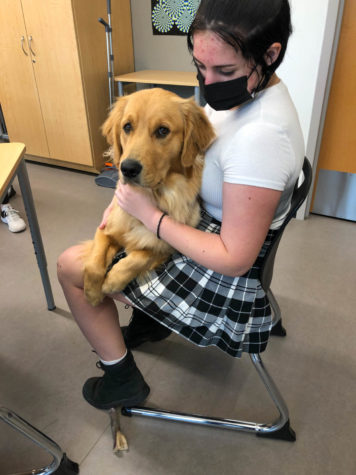
“I love having Willow around,” senior Lisanne Dobson said. “I just stop in there to say hi sometimes and her deep pressure therapy helped me a lot with the stress of senior year.” Dobson was referring to the comforting weight of the dog in her lap.
An Instagram account titled “learningwithwillow” was created by Schoblaske in the excitement of having Willow at school.
On her days off, Willow spent her time playing in the dog park and running around in her cul de sac with the neighbor dogs.
Willow left to meet her person, Ashley Elaine White, on Oct. 29.
“I personally have never had my own fully trained service dog. When I started this journey three years ago, I attempted to train my own dog and it was quite difficult to do on my own,” White shared. “I actually found out about the SDC from an Instagram post that popped up on my feed of baby Willow who was looking for a puppy raiser and the rest was history.”
White has a heart condition called Wolf-Parkinson-White (WPW) which causes tachycardia episodes. In WPW syndrome, there is an extra electrical pathway between the heart’s upper and lower chambers which causes a person to have a rapid heart rate. The condition is present at birth and is fairly rare. While the episodes of fast heartbeats aren’t life threatening, they can cause serious heart problems. Symptoms may include fainting, chest pain, difficulty breathing, fatigue, anxiety, shortness of breath, dizziness or lightheadedness, and palpitations. Treatment and medication can help prevent the episodes.
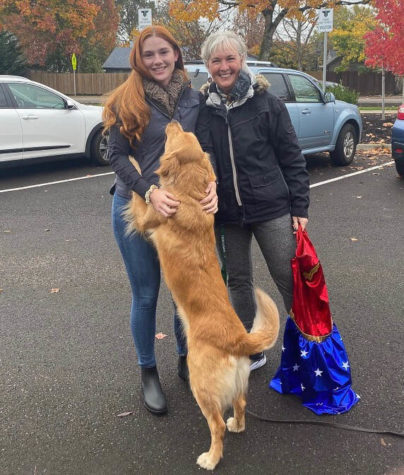
Willow will be trained specifically to perform cardiac alert tasks as well as light mobility tasks. For a cardiac alert Willow will be able to smell when White’s stress hormones and adrenaline rises before she has a heart episode which normally causes her to pass out or feel very sick.
“With her being able to alert me to this prior to feeling symptoms, I can take medication to counteract the episode or at least sit down before I take a spill,” White explained.
For mobility work, Willow will help White by balancing her with a mobility harness, so if she does feel faint during a heart episode, Willow will be there to support her. During White’s dizzy spells, Willow helps keep her oriented. Willow will also be there by White’s side to help pick up anything she may drop out in public, like her phone or keys.
“I also have a degenerative condition called spinal stenosis which can cause my lower back to hurt quite a bit,” White said. “So on those days I can’t fully bend over, Willow will be there to give me some independence from those around me instead of having to ask others to pick it up for me.”
Spinal stenosis is a condition in which there is narrowing of the spaces within the spine. This causes pressure on the nerves that travel through the spine.
In order for White and Willow to be deemed a team, they will work through the public access test. This test makes sure that they will be able to operate together safely in public and that Willow is capable of behaving in various different situations. Willow and White will be tested on various commands like sitting on command, controlled entry through a doorway, noise distraction, off lead, downs on command, etc. Scoring is done through YES and NO as well as letter grading, AMSN. Meaning, always, most of the time, some of the time, and never. In order to pass the test, the team must score all “Always” or “Most of the time” in response to the AMSN part of the test, and must score at least an 80% “yes” on the “YES” “NO” part of the test.
“Once we are able to pass the test, then Willow and I would be a fully functioning service dog team,” White shared. “As far as when she is working and when she is off duty really depends on the vest!”
White plans on requiring WIllow to wear her vest while out in public. However, while at home and the vest comes off Willow is allowed to be a normal dog. White loves watching Willow romp around at the dog beach or run zoomies in the backyard.
“I definitely want to give her the best normal-dog life possible when she isn’t working for me,” White explained. “However, for her tasks, those are things she would still do even without the vest on. These are all things she loves to do because she has that working dog mentality, working for her human makes her feel good.”


